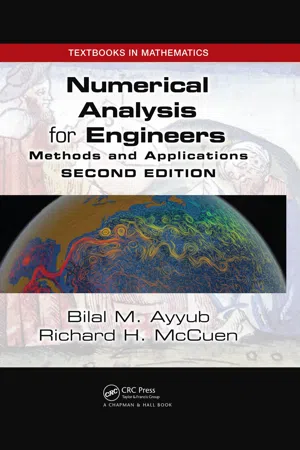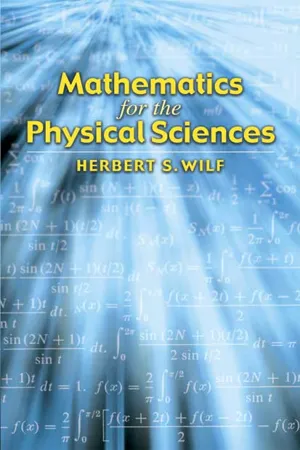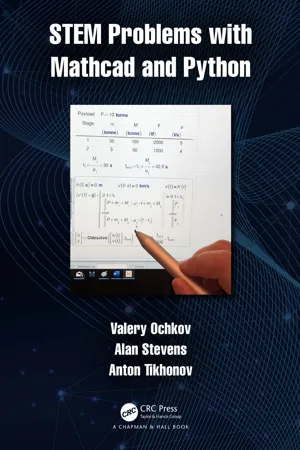Mathematics
Location of Roots
The location of roots refers to the values of a variable that make a polynomial equation equal to zero. These values can be found using various methods such as factoring, the quadratic formula, or graphing. The number and type of roots can provide information about the behavior of the polynomial function.
Written by Perlego with AI-assistance
Related key terms
Related key terms
1 of 4
Related key terms
1 of 3
4 Key excerpts on "Location of Roots"
- eBook - ePub
- Darren Walker(Author)
- 2022(Publication Date)
- Mercury Learning and Information(Publisher)
4 SEARCHING FOR ROOTS4.1 FINDING ROOTSA root-finding algorithm is a numerical method, or algorithm, for finding a value x such that , for a given function f . Such an x is called a root of the function f . This type of problem occurs often in physics and science in general, typically as a starting point or intermediary process of a larger problem, though sometimes it is the problem.Generally, computing the root of a function cannot be done analytically and this is especially true when a function is not represented by a low order polynomial. Closed-form solutions for the roots exist for polynomials up to the fourth orderHowever, no such general solutions exist for order five polynomials or higher. Factorization can be used in finding the roots of a polynomial equation but tends to be viable only for well-chosen coefficients, that is, no messy fractions to deal with. For equations that are not polynomial, analytical solutions are few and far between.Finding a root of is the same as solving the equation . Here, x is called the unknown in the equation. Any equation can take the form , so equation solving, that is, finding x, is the same thing as computing a root of a function. One of the first techniques you should have been taught to find the root of is to plot graphs of the two functions on the same coordinate system; the x value of where the two functions intersect is the root. Clearly, this has accuracy limitations stemming from the precision of the human eye and the thickness of pencil lines. Unless one is willing to draw a massive graph, this technique should be reserved for providing a rough estimate of the root, which can be passed as an initial guess to a numerical root-finding algorithm. Root-finding methods, provided with an initial guess, use iteration to produce a sequence of numbers that hopefully converge toward a unique value, the root you wish to find. The methods are recursive in nature, that is they compute subsequent values based on current and/or previous values of x , , and derivatives of - eBook - ePub
Numerical Analysis for Engineers
Methods and Applications, Second Edition
- Bilal Ayyub, Richard H. McCuen(Authors)
- 2015(Publication Date)
- Chapman and Hall/CRC(Publisher)
4Roots of Equations
4.1 Introduction
The solution of many scientific and engineering problems requires finding the roots of equations that can be nonlinear. Any nonlinear equation can, after suitable algebraic manipulation, be expressed as a function of the following form:(4.1)f ( x ) = 0The values of x that satisfy the condition of Equation 4.1 are termed the roots of the function; these roots are the solution to the equation f (x ) = 0. Figure 4.1 shows graphically the roots for selected functions within an interval of interest [A , B ]. Figure 4.1a shows a nonlinear function without roots since the function does not intersect the x axis. Figures 4.1b through d show functions with one, two, and three roots, respectively.FIGURE 4.1 Roots for selected functions: (a) no roots, (b) one root, (c) two roots, and (d) three roots.For very simple functions, the roots can often be found analytically. For example, for the general second-order polynomial ax 2 + bx + c = 0, the roots x 1 and x 2 can be found analytically using the following equation:(4.2)x 1=- b +b 2- 4 a c2 aThe roots for a third-order polynomial can also be found analytically. However, a general solution does not exist for other higher order polynomials.(4.3)x 2=- b -b 2- 4 a c2 aIt is more difficult to obtain analytical solutions for the roots of non-polynomial, nonlinear functions. For example, the function (x /2)2 − sin(x ) = 0 cannot be solved analytically. To obtain the roots of this function, some type of numerical method must be employed. This, in general, requires a large number of calculations, particularly if the roots are to be determined to a high degree of precision. Thus, the problem is well suited to numerical analysis.4.2 Eigenvalue Analysis
A large number of engineering problems require the determination of a set of values called eigenvalues or characteristic values . These are values, usually denoted as λ, for which the following matrix system has a nonzero (i.e., nontrivial) solution vector X - eBook - ePub
- Herbert S Wilf(Author)
- 2013(Publication Date)
- Dover Publications(Publisher)
chapter 3The roots of polynomial equations
3.1 INTRODUCTION
A function f (z ) of the form(1)of the complex variable z , with complex coefficients a 0 , a 1 , . . . , a n is a polynomial of degree n . A complex number z 0 , having the property that f (z 0 ) = 0 is called a root of the equation f (z ) = 0, or a zero of the polynomial f (z ). We will assume throughout, for simplicity, that in (1) a 0 ≠ 0 and an ≠ 0, which can always be achieved in a trivial manner.We further assume that the reader is familiar with the fact that f (z ) of (1) always has exactly n zeros z 1 , z 2 , . . . , z n in the complex plane and may be factored in the form(2)Our concern in this chapter is almost entirely with the analytic (as opposed to the algebraic) theory of polynomial equations. Roughly speaking, this theory is concerned with describing the position of the zeros in the complex plane, without actually solving the equation, as accurately as possible in terms of easily calculated functions of the coefficients.Specifically, we list the following questions, all of which are answered more or less completely in the following sections:1. Suppose we know the zeros of f (z ). What can be said about the zeros f ′(z ) ?2. What circle |z | R , in the complex plane, surely contains all the zeros of f (z )?3. How many zeros does f (z ) have in the left (right) half plane? In the unit circle? On the real axis? On the real interval [a , b ]? In the sector α arg z β ?4. How can we efficiently calculate the zeros of f (z )?3.2 THE GAUSS-LUCAS THEOREM
Let us recall—from elementary calculus—the theorem of Rolle, which asserts that if f (a ) = f (b ) = 0, then f ′(x ) = 0 somewhere between a and b, f (x ) being continuously differentiable in (a , b ). Viewed otherwise, this theorem states that if z 1 , z 2 are two real zeros of f (z ), then f ′(z ) has a zero somewhere between z 1 , z 2 . We propose to generalize this result to the case of arbitrary complex zeros, z 1, z 2 , . . . , z n - eBook - ePub
- Valery Ochkov, Alan Stevens, Anton Tikhonov(Authors)
- 2022(Publication Date)
- Chapman and Hall/CRC(Publisher)
Further, a graph is constructed using the resulting function near the region of interest to us for the change of the unknown x. The zero of the function is clearly visible on the graph (the point of intersection of the curve with the abscissa axis), the more or less exact value of which is found using the built-in root function. This will be the desired value x 3, by which the value y 3 was found through the function f. A subsequent check shows that this is the desired root, which we could not previously calculate using the Find function. FIGURE 1.8 Finding the root of a system of two equations by substituting one equation into another. The root function with four arguments does not rely on the first guess, which occurs when calling it with two arguments, but on the values of the ends of the interval where the zero of the function is searched (the root of equation f (x) = 0). The Find function, unfortunately, cannot work with a given interval—it only works based on the initial guess, which often finds a solution far from the expected one. We can deal with this state of affairs by understanding the essence of the numerical method embedded in the Find function. And we can do it in a different, somewhat original way, by constructing a portrait of the roots of the system of equations. To do this, we will choose another system of equations with four roots, which we might call a heart pierced by an arrow—see Figure 1.9. FIGURE 1.9 Portrait of the roots of the system of equations “Heart pierced by an arrow”
Index pages curate the most relevant extracts from our library of academic textbooks. They’ve been created using an in-house natural language model (NLM), each adding context and meaning to key research topics.
Explore more topic indexes
Explore more topic indexes
1 of 6
Explore more topic indexes
1 of 4



